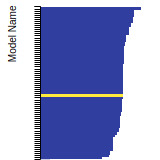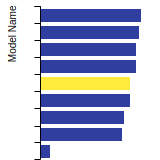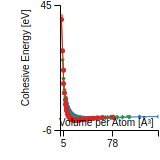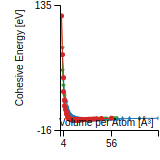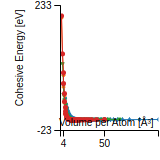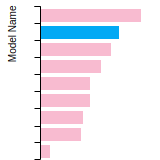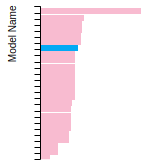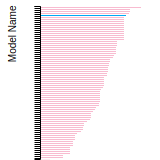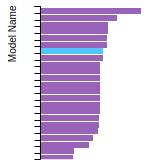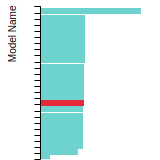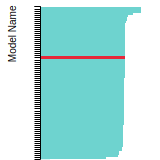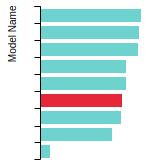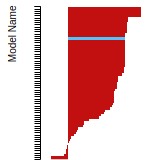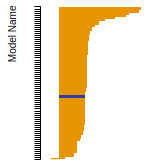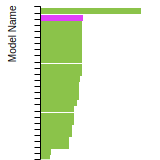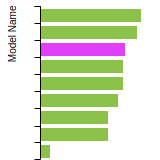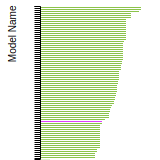 MEAM_LAMMPS_DickelBaskesAslam_2018_MgAlZn__MO_093637366498_002
MEAM_LAMMPS_DickelBaskesAslam_2018_MgAlZn__MO_093637366498_002
| Title
A single sentence description.
|
MEAM potential for Mg–Al–Zn alloys developed by Dickel et al. (2018) v002 |
|---|---|
| Description
A short description of the Model describing its key features including for example: type of model (pair potential, 3-body potential, EAM, etc.), modeled species (Ac, Ag, ..., Zr), intended purpose, origin, and so on.
|
Because of its substantial c/a ratio, Zn has proven to be a problematic element to model using semi-empirical classical potentials. It has been shown, in particular, that for the modified embedded atom method (MEAM), a potential cannot simultaneously have an hcp ground state and c/a ratio greater than ideal. However, as an alloying element, practical Zn potentials can be generated by relaxing the condition that hcp be the lowest energy structure. A MEAM Zn potential is developed, which gives accurate material properties for the pure state and a MEAM ternary potential for the Mg-Al–Zn system, which will allow the atomistic modeling of a broad class of alloys containing Zn. Zn's effects in simple Mg–Zn results for this potential verifies the accuracy for the new potential in these systems. |
| Species
The supported atomic species.
| Al, Mg, Zn |
| Disclaimer
A statement of applicability provided by the contributor, informing users of the intended use of this KIM Item.
|
None |
| Content Origin | Files are provided by Doyl E Dickel (Mississippi State University) on Mar 6, 2021, and posted with his permission. |
| Contributor |
Yaser Afshar |
| Maintainer |
Yaser Afshar |
| Developer |
Doyl E. Dickel Michael I. Baskes Imran Aslam Christopher D. Barrett |
| Published on KIM | 2023 |
| How to Cite |
This Model originally published in [1] is archived in OpenKIM [2-5]. [1] Dickel DE, Baskes MI, Aslam I, Barrett CD. New interatomic potential for Mg–Al–Zn alloys with specific application to dilute Mg-based alloys. Modelling and Simulation in Materials Science and Engineering. 2018Apr;26(4):045010. doi:10.1088/1361-651x/aabaad — (Primary Source) A primary source is a reference directly related to the item documenting its development, as opposed to other sources that are provided as background information. [2] Dickel DE, Baskes MI, Aslam I, Barrett CD. MEAM potential for Mg–Al–Zn alloys developed by Dickel et al. (2018) v002. OpenKIM; 2023. doi:10.25950/ca972fcb [3] Afshar Y, Hütter S, Rudd RE, Stukowski A, Tipton WW, Trinkle DR, et al. The modified embedded atom method (MEAM) potential v002. OpenKIM; 2023. doi:10.25950/ee5eba52 [4] Tadmor EB, Elliott RS, Sethna JP, Miller RE, Becker CA. The potential of atomistic simulations and the Knowledgebase of Interatomic Models. JOM. 2011;63(7):17. doi:10.1007/s11837-011-0102-6 [5] Elliott RS, Tadmor EB. Knowledgebase of Interatomic Models (KIM) Application Programming Interface (API). OpenKIM; 2011. doi:10.25950/ff8f563a Click here to download the above citation in BibTeX format. |
| Citations
This panel presents information regarding the papers that have cited the interatomic potential (IP) whose page you are on. The OpenKIM machine learning based Deep Citation framework is used to determine whether the citing article actually used the IP in computations (denoted by "USED") or only provides it as a background citation (denoted by "NOT USED"). For more details on Deep Citation and how to work with this panel, click the documentation link at the top of the panel. The word cloud to the right is generated from the abstracts of IP principle source(s) (given below in "How to Cite") and the citing articles that were determined to have used the IP in order to provide users with a quick sense of the types of physical phenomena to which this IP is applied. The bar chart shows the number of articles that cited the IP per year. Each bar is divided into green (articles that USED the IP) and blue (articles that did NOT USE the IP). Users are encouraged to correct Deep Citation errors in determination by clicking the speech icon next to a citing article and providing updated information. This will be integrated into the next Deep Citation learning cycle, which occurs on a regular basis. OpenKIM acknowledges the support of the Allen Institute for AI through the Semantic Scholar project for providing citation information and full text of articles when available, which are used to train the Deep Citation ML algorithm. |
This panel provides information on past usage of this interatomic potential (IP) powered by the OpenKIM Deep Citation framework. The word cloud indicates typical applications of the potential. The bar chart shows citations per year of this IP (bars are divided into articles that used the IP (green) and those that did not (blue)). The complete list of articles that cited this IP is provided below along with the Deep Citation determination on usage. See the Deep Citation documentation for more information. 
37 Citations (24 used)
Help us to determine which of the papers that cite this potential actually used it to perform calculations. If you know, click the .
USED (high confidence) G. Esteban-Manzanares, R. Alizadeh, I. Papadimitriou, D. Dickel, C. Barrett, and J. Llorca, “Atomistic simulations of the interaction of basal dislocations with MgZn2 precipitates in Mg alloys,” Materials Science and Engineering: A. 2020. link Times cited: 14 USED (high confidence) S. Subedi, L. Morrissey, S. M. Handrigan, and S. Nakhla, “The effect of many-body potential type and parameterisation on the accuracy of predicting mechanical properties of aluminium using molecular dynamics,” Molecular Simulation. 2020. link Times cited: 8 Abstract: ABSTRACT As opposed to traditional laboratory testing, Molec… read more USED (high confidence) G. Esteban-Manzanares, A. Ma, I. Papadimitriou, E. Martínez, and J. Llorca, “Basal dislocation/precipitate interactions in Mg–Al alloys: an atomistic investigation,” Modelling and Simulation in Materials Science and Engineering. 2019. link Times cited: 19 Abstract: The interaction between edge basal dislocations and β-Mg17Al… read more USED (low confidence) J. Peng, J. Li, B. Liu, Q. Fang, and P. K. Liaw, “Origin of thermal deformation induced crystallization and microstructure formation in additive manufactured FCC, BCC, HCP metals and its alloys,” International Journal of Plasticity. 2023. link Times cited: 0 USED (low confidence) Y. Pu et al., “Formation and fracture of Mg88Al6Zn6 MGs analyzed by topologically close-packed cluster correlation,” Journal of Materials Research and Technology. 2023. link Times cited: 0 USED (low confidence) Y. Sun and Y.-gui Chen, “Atomistic modeling of Mg-Al-Zn solid–liquid interfacial free energy,” Computational Materials Science. 2023. link Times cited: 0 USED (low confidence) M. Motamedi, M. H. Nikzad, and M. R. Nasri, “e Mixture design optimization and machine learning-based prediction of Al-Mg alloy composite reinforced by Zn nanoparticles: A molecular dynamics study,” Materials Today Communications. 2023. link Times cited: 0 USED (low confidence) X. Zhang, J. Li, Y. Shi, Q. Chen, and H. Yue, “Microstructure evolution of AZ80 magnesium alloy in semi-solid compression by molecular dynamics simulation,” Journal of Materials Research and Technology. 2023. link Times cited: 0 USED (low confidence) G. Zhang, S. Zhang, R. Song, and C. Cai, “Effect of Mg and Si Contents on Hot-Dip 55Al-Zn Plating: Experimental and Molecular Dynamics Simulation,” Materials Today Communications. 2023. link Times cited: 1 USED (low confidence) T. Wen et al., “Modelling of dislocations, twins and crack-tips in HCP and BCC Ti,” International Journal of Plasticity. 2023. link Times cited: 4 USED (low confidence) S. Zhang, R. Song, C. Cai, and S. Zhao, “Diffusion and reaction mechanism in initial stage of Zn–Al–Mg hot-dip coating: molecular dynamics simulation,” Journal of Materials Science. 2023. link Times cited: 1 USED (low confidence) X. Pan et al., “Microstructure and residual stress modulation of 7075 aluminum alloy for improving fatigue performance by laser shock peening,” International Journal of Machine Tools and Manufacture. 2023. link Times cited: 22 USED (low confidence) B. Waters, D. S. Karls, I. Nikiforov, R. Elliott, E. Tadmor, and B. Runnels, “Automated determination of grain boundary energy and potential-dependence using the OpenKIM framework,” Computational Materials Science. 2022. link Times cited: 5 USED (low confidence) A. Clément and T. Auger, “An EAM potential for α-brass copper–zinc alloys: application to plasticity and fracture,” Modelling and Simulation in Materials Science and Engineering. 2022. link Times cited: 1 Abstract: An embedded atom method potential has been developed for cop… read more USED (low confidence) D. F. Shi, A. Ma, M. Pérez-Prado, and C. Cepeda-Jiménez, “Activation of second-order pyramidal slip and other secondary mechanisms in solid solution Mg-Zn alloys and their effect on tensile ductility,” Acta Materialia. 2022. link Times cited: 10 USED (low confidence) B. Cai, J. Li, W. Lai, J.-bo Liu, and B.-xin Liu, “Construction of Al-Mg-Zn Interatomic Potential and the Prediction of Favored Glass Formation Compositions and Associated Driving Forces,” Materials. 2022. link Times cited: 2 Abstract: An interatomic potential is constructed for the ternary Al-M… read more USED (low confidence) X. Yang, S. Xu, and L. Liu, “The Shock Response and Spall Mechanism of Mg–Al–Zn Alloy: Molecular Dynamics Study,” Acta Mechanica Solida Sinica. 2022. link Times cited: 7 USED (low confidence) A. Mahata, T. Mukhopadhyay, and M. A. Zaeem, “Modified embedded-atom method interatomic potentials for Al-Cu, Al-Fe and Al-Ni binary alloys: From room temperature to melting point,” Computational Materials Science. 2022. link Times cited: 27 USED (low confidence) S. Sarmah, N. Kumar, J. Patil, M. Paliwal, and R. S. Ayyagari, “A unified modeling approach and experimental validation to predict the mechanical properties in age hardened magnesium alloys,” Mechanics of Materials. 2022. link Times cited: 2 USED (low confidence) Z. Jian et al., “Shock-induced plasticity and phase transformation in single crystal magnesium: an interatomic potential and non-equilibrium molecular dynamics simulations,” Journal of Physics: Condensed Matter. 2021. link Times cited: 8 Abstract: An effective and reliable Finnis–Sinclair (FS) type potentia… read more USED (low confidence) M. Niewczas and A. Kula, “Formation of polytypes structures in Mg single crystals,” Acta Materialia. 2021. link Times cited: 2 USED (low confidence) H.-S. Jang, D. Seol, and B.-J. Lee, “Modified embedded-atom method interatomic potentials for Mg–Al–Ca and Mg–Al–Zn ternary systems,” Journal of Magnesium and Alloys. 2020. link Times cited: 28 USED (low confidence) Y. Liu, H. Yan, and X. Cui, “Underlying Mechanisms of the Electrolyte Structure and Dynamics on the Doped-Anode of Magnesium Batteries Based on the Molecular Dynamics Simulations,” Journal of Electrochemical Energy Conversion and Storage. 2020. link Times cited: 1 Abstract: As a potential energy storage cell, the rechargeable magnesi… read more USED (low confidence) I. Aslam et al., “Thermodynamic and kinetic behavior of low-alloy steels: An atomic level study using an Fe-Mn-Si-C modified embedded atom method (MEAM) potential,” Materialia. 2019. link Times cited: 12 NOT USED (low confidence) H. Mei, L. Cheng, L. Chen, F. Wang, J. Li, and L. Kong, “Development of machine learning interatomic potential for zinc,” Computational Materials Science. 2024. link Times cited: 0 NOT USED (low confidence) Y. Ji, C. Dong, L. Chen, K. Xiao, and X. Li, “High-throughput computing for screening the potential alloying elements of a 7xxx aluminum alloy for increasing the alloy resistance to stress corrosion cracking,” Corrosion Science. 2021. link Times cited: 14 NOT USED (low confidence) Z. Aitken, V. Sorkin, Z. Yu, S. Chen, Z. Wu, and Y.-W. Zhang, “Modified embedded-atom method potentials for the plasticity and fracture behaviors of unary fcc metals,” Physical Review B. 2021. link Times cited: 5 NOT USED (low confidence) M. S. Nitol, D. Dickel, and C. Barrett, “Artificial neural network potential for pure zinc,” Computational Materials Science. 2021. link Times cited: 11 NOT USED (low confidence) T. Yang et al., “Self-accommodated defect structures modifying the growth of Laves phase,” Journal of Materials Science & Technology. 2021. link Times cited: 12 NOT USED (low confidence) J. F. Troncoso and V. Turlo, “Evaluating the applicability of classical and neural network interatomic potentials for modeling body centered cubic polymorph of magnesium,” Modelling and Simulation in Materials Science and Engineering. 2022. link Times cited: 2 Abstract: Magnesium (Mg) is one of the most abundant metallic elements… read more NOT USED (high confidence) T. Wen et al., “Atomistic Modelling of All Dislocations and Twins in HCP and BCC Ti,” SSRN Electronic Journal. 2022. link Times cited: 0 Abstract: Ti exhibits complex plastic deformation controlled by active… read more NOT USED (high confidence) M. Poul, L. Huber, E. Bitzek, and J. Neugebauer, “Systematic atomic structure datasets for machine learning potentials: Application to defects in magnesium,” Physical Review B. 2022. link Times cited: 3 Abstract: We present a physically motivated strategy for the construct… read more NOT USED (high confidence) H. Wang, Y. Zhang, L. Zhang, and H. Wang, “Crystal Structure Prediction of Binary Alloys via Deep Potential,” Frontiers in Chemistry. 2020. link Times cited: 9 Abstract: Predicting crystal structure has been a challenging problem … read more NOT USED (high confidence) D. R. Pratt, L. Morrissey, and S. Nakhla, “Molecular dynamics simulations of nanoindentation – the importance of force field choice on the predicted elastic modulus of FCC aluminum,” Molecular Simulation. 2020. link Times cited: 5 Abstract: ABSTRACT Molecular Dynamics (MD) was used to determine the a… read more NOT USED (high confidence) W. Y. Huen, H.-S. Lee, V. Vimonsatit, P. Mendis, and H.-seung Lee, “Transversely isotropic elastic-plastic properties in thermal arc sprayed Al–Zn coating: a microporomechanics approach,” Scientific Reports. 2020. link Times cited: 3 NOT USED (high confidence) M. Alidoust, D. Kleiven, and J. Akola, “Density functional simulations of pressurized Mg-Zn and Al-Zn alloys,” Physical Review Materials. 2020. link Times cited: 5 Abstract: The Mg-Zn and Al-Zn binary alloys have been investigated the… read more NOT USED (high confidence) S.-J. Sun, S. Ju, C.-C. Yang, K.-C. Chang, and I.-J. Lee, “Effects of Strontium incorporation to Mg-Zn-Ca biodegradable bulk metallic glass investigated by molecular dynamics simulation and density functional theory calculation,” Scientific Reports. 2020. link Times cited: 6 |
| Funding | Not available |
| Short KIM ID
The unique KIM identifier code.
| MO_093637366498_002 |
| Extended KIM ID
The long form of the KIM ID including a human readable prefix (100 characters max), two underscores, and the Short KIM ID. Extended KIM IDs can only contain alpha-numeric characters (letters and digits) and underscores and must begin with a letter.
| MEAM_LAMMPS_DickelBaskesAslam_2018_MgAlZn__MO_093637366498_002 |
| DOI |
10.25950/ca972fcb https://doi.org/10.25950/ca972fcb https://commons.datacite.org/doi.org/10.25950/ca972fcb |
| KIM Item Type
Specifies whether this is a Portable Model (software implementation of an interatomic model); Portable Model with parameter file (parameter file to be read in by a Model Driver); Model Driver (software implementation of an interatomic model that reads in parameters).
| Portable Model using Model Driver MEAM_LAMMPS__MD_249792265679_002 |
| Driver | MEAM_LAMMPS__MD_249792265679_002 |
| KIM API Version | 2.2 |
| Potential Type | meam |
| Previous Version | MEAM_LAMMPS_DickelBaskesAslam_2018_MgAlZn__MO_093637366498_001 |
| Grade | Name | Category | Brief Description | Full Results | Aux File(s) |
|---|---|---|---|---|---|
| P | vc-species-supported-as-stated | mandatory | The model supports all species it claims to support; see full description. |
Results | Files |
| P | vc-periodicity-support | mandatory | Periodic boundary conditions are handled correctly; see full description. |
Results | Files |
| P | vc-permutation-symmetry | mandatory | Total energy and forces are unchanged when swapping atoms of the same species; see full description. |
Results | Files |
| A | vc-forces-numerical-derivative | consistency | Forces computed by the model agree with numerical derivatives of the energy; see full description. |
Results | Files |
| F | vc-dimer-continuity-c1 | informational | The energy versus separation relation of a pair of atoms is C1 continuous (i.e. the function and its first derivative are continuous); see full description. |
Results | Files |
| P | vc-objectivity | informational | Total energy is unchanged and forces transform correctly under rigid-body translation and rotation; see full description. |
Results | Files |
| P | vc-inversion-symmetry | informational | Total energy is unchanged and forces change sign when inverting a configuration through the origin; see full description. |
Results | Files |
| P | vc-memory-leak | informational | The model code does not have memory leaks (i.e. it releases all allocated memory at the end); see full description. |
Results | Files |
| P | vc-thread-safe | mandatory | The model returns the same energy and forces when computed in serial and when using parallel threads for a set of configurations. Note that this is not a guarantee of thread safety; see full description. |
Results | Files |
| P | vc-unit-conversion | mandatory | The model is able to correctly convert its energy and/or forces to different unit sets; see full description. |
Results | Files |
BCC Lattice Constant
This bar chart plot shows the mono-atomic body-centered cubic (bcc) lattice constant predicted by the current model (shown in the unique color) compared with the predictions for all other models in the OpenKIM Repository that support the species. The vertical bars show the average and standard deviation (one sigma) bounds for all model predictions. Graphs are generated for each species supported by the model.
Cohesive Energy Graph
This graph shows the cohesive energy versus volume-per-atom for the current mode for four mono-atomic cubic phases (body-centered cubic (bcc), face-centered cubic (fcc), simple cubic (sc), and diamond). The curve with the lowest minimum is the ground state of the crystal if stable. (The crystal structure is enforced in these calculations, so the phase may not be stable.) Graphs are generated for each species supported by the model.
Diamond Lattice Constant
This bar chart plot shows the mono-atomic face-centered diamond lattice constant predicted by the current model (shown in the unique color) compared with the predictions for all other models in the OpenKIM Repository that support the species. The vertical bars show the average and standard deviation (one sigma) bounds for all model predictions. Graphs are generated for each species supported by the model.
Dislocation Core Energies
This graph shows the dislocation core energy of a cubic crystal at zero temperature and pressure for a specific set of dislocation core cutoff radii. After obtaining the total energy of the system from conjugate gradient minimizations, non-singular, isotropic and anisotropic elasticity are applied to obtain the dislocation core energy for each of these supercells with different dipole distances. Graphs are generated for each species supported by the model.
(No matching species)FCC Elastic Constants
This bar chart plot shows the mono-atomic face-centered cubic (fcc) elastic constants predicted by the current model (shown in blue) compared with the predictions for all other models in the OpenKIM Repository that support the species. The vertical bars show the average and standard deviation (one sigma) bounds for all model predictions. Graphs are generated for each species supported by the model.
FCC Lattice Constant
This bar chart plot shows the mono-atomic face-centered cubic (fcc) lattice constant predicted by the current model (shown in red) compared with the predictions for all other models in the OpenKIM Repository that support the species. The vertical bars show the average and standard deviation (one sigma) bounds for all model predictions. Graphs are generated for each species supported by the model.
FCC Stacking Fault Energies
This bar chart plot shows the intrinsic and extrinsic stacking fault energies as well as the unstable stacking and unstable twinning energies for face-centered cubic (fcc) predicted by the current model (shown in blue) compared with the predictions for all other models in the OpenKIM Repository that support the species. The vertical bars show the average and standard deviation (one sigma) bounds for all model predictions. Graphs are generated for each species supported by the model.
FCC Surface Energies
This bar chart plot shows the mono-atomic face-centered cubic (fcc) relaxed surface energies predicted by the current model (shown in blue) compared with the predictions for all other models in the OpenKIM Repository that support the species. The vertical bars show the average and standard deviation (one sigma) bounds for all model predictions. Graphs are generated for each species supported by the model.
SC Lattice Constant
This bar chart plot shows the mono-atomic simple cubic (sc) lattice constant predicted by the current model (shown in the unique color) compared with the predictions for all other models in the OpenKIM Repository that support the species. The vertical bars show the average and standard deviation (one sigma) bounds for all model predictions. Graphs are generated for each species supported by the model.
Cubic Crystal Basic Properties Table
Species: AlSpecies: Mg
Species: Zn
Creators:
Contributor: karls
Publication Year: 2019
DOI: https://doi.org/10.25950/64cb38c5
This Test Driver uses LAMMPS to compute the cohesive energy of a given monoatomic cubic lattice (fcc, bcc, sc, or diamond) at a variety of lattice spacings. The lattice spacings range from a_min (=a_min_frac*a_0) to a_max (=a_max_frac*a_0) where a_0, a_min_frac, and a_max_frac are read from stdin (a_0 is typically approximately equal to the equilibrium lattice constant). The precise scaling and number of lattice spacings sampled between a_min and a_0 (a_0 and a_max) is specified by two additional parameters passed from stdin: N_lower and samplespacing_lower (N_upper and samplespacing_upper). Please see README.txt for further details.
Creators:
Contributor: ilia
Publication Year: 2024
DOI: https://doi.org/10.25950/888f9943
Computes the elastic constants for an arbitrary crystal. A robust computational protocol is used, attempting multiple methods and step sizes to achieve an acceptably low error in numerical differentiation and deviation from material symmetry. The crystal structure is specified using the AFLOW prototype designation as part of the Crystal Genome testing framework. In addition, the distance from the obtained elasticity tensor to the nearest isotropic tensor is computed.
| Test | Test Results | Link to Test Results page | Benchmark time
Usertime multiplied by the Whetstone Benchmark. This number can be used (approximately) to compare the performance of different models independently of the architecture on which the test was run.
Measured in Millions of Whetstone Instructions (MWI) |
|---|---|---|---|
| Elastic constants for AlMg in AFLOW crystal prototype A12B17_cI58_217_g_acg at zero temperature and pressure v000 | view | 823723 | |
| Elastic constants for AlMg in AFLOW crystal prototype A14B13_cI54_229_ef_ah at zero temperature and pressure v000 | view | 1282911 | |
| Elastic constants for MgZn in AFLOW crystal prototype A2B11_cP39_200_f_begik at zero temperature and pressure v000 | view | 2022723 |
Creators: Junhao Li and Ellad Tadmor
Contributor: tadmor
Publication Year: 2019
DOI: https://doi.org/10.25950/5853fb8f
Computes the cubic elastic constants for some common crystal types (fcc, bcc, sc, diamond) by calculating the hessian of the energy density with respect to strain. An estimate of the error associated with the numerical differentiation performed is reported.
Creators:
Contributor: ilia
Publication Year: 2024
DOI: https://doi.org/10.25950/2f2c4ad3
Computes the equilibrium crystal structure and energy for an arbitrary crystal at zero temperature and applied stress by performing symmetry-constrained relaxation. The crystal structure is specified using the AFLOW prototype designation. Multiple sets of free parameters corresponding to the crystal prototype may be specified as initial guesses for structure optimization. No guarantee is made regarding the stability of computed equilibria, nor that any are the ground state.
Creators:
Contributor: brunnels
Publication Year: 2022
DOI: https://doi.org/10.25950/2c59c9d6
Computes grain boundary energy for a range of tilt angles given a crystal structure, tilt axis, and material.
| Test | Test Results | Link to Test Results page | Benchmark time
Usertime multiplied by the Whetstone Benchmark. This number can be used (approximately) to compare the performance of different models independently of the architecture on which the test was run.
Measured in Millions of Whetstone Instructions (MWI) |
|---|---|---|---|
| Relaxed energy as a function of tilt angle for a 100 symmetric tilt grain boundary in fcc Al v003 | view | 49975766 | |
| Relaxed energy as a function of tilt angle for a 111 symmetric tilt grain boundary in fcc Al v001 | view | 76862499 |
Creators: Daniel S. Karls and Junhao Li
Contributor: karls
Publication Year: 2019
DOI: https://doi.org/10.25950/2765e3bf
Equilibrium lattice constant and cohesive energy of a cubic lattice at zero temperature and pressure.
Creators: Daniel S. Karls and Junhao Li
Contributor: karls
Publication Year: 2019
DOI: https://doi.org/10.25950/c339ca32
Calculates lattice constant of hexagonal bulk structures at zero temperature and pressure by using simplex minimization to minimize the potential energy.
| Test | Test Results | Link to Test Results page | Benchmark time
Usertime multiplied by the Whetstone Benchmark. This number can be used (approximately) to compare the performance of different models independently of the architecture on which the test was run.
Measured in Millions of Whetstone Instructions (MWI) |
|---|---|---|---|
| Equilibrium lattice constants for hcp Al v005 | view | 420656 | |
| Equilibrium lattice constants for hcp Mg v005 | view | 501061 | |
| Equilibrium lattice constants for hcp Zn v005 | view | 501503 |
Creators:
Contributor: mjwen
Publication Year: 2024
DOI: https://doi.org/10.25950/9d9822ec
This Test Driver uses LAMMPS to compute the linear thermal expansion coefficient at a finite temperature under a given pressure for a cubic lattice (fcc, bcc, sc, diamond) of a single given species.
| Test | Test Results | Link to Test Results page | Benchmark time
Usertime multiplied by the Whetstone Benchmark. This number can be used (approximately) to compare the performance of different models independently of the architecture on which the test was run.
Measured in Millions of Whetstone Instructions (MWI) |
|---|---|---|---|
| Linear thermal expansion coefficient of fcc Al at 293.15 K under a pressure of 0 MPa v002 | view | 6093985 |
Creators: Matt Bierbaum
Contributor: mattbierbaum
Publication Year: 2019
DOI: https://doi.org/10.25950/64f4999b
Calculates the phonon dispersion relations for fcc lattices and records the results as curves.
| Test | Test Results | Link to Test Results page | Benchmark time
Usertime multiplied by the Whetstone Benchmark. This number can be used (approximately) to compare the performance of different models independently of the architecture on which the test was run.
Measured in Millions of Whetstone Instructions (MWI) |
|---|---|---|---|
| Phonon dispersion relations for fcc Al v004 | view | 96973 |
Creators:
Contributor: SubrahmanyamPattamatta
Publication Year: 2019
DOI: https://doi.org/10.25950/b4cfaf9a
Intrinsic and extrinsic stacking fault energies, unstable stacking fault energy, unstable twinning energy, stacking fault energy as a function of fractional displacement, and gamma surface for a monoatomic FCC lattice at zero temperature and pressure.
| Test | Test Results | Link to Test Results page | Benchmark time
Usertime multiplied by the Whetstone Benchmark. This number can be used (approximately) to compare the performance of different models independently of the architecture on which the test was run.
Measured in Millions of Whetstone Instructions (MWI) |
|---|---|---|---|
| Stacking and twinning fault energies for fcc Al v002 | view | 98907375 |
Creators: Matt Bierbaum
Contributor: mattbierbaum
Publication Year: 2019
DOI: https://doi.org/10.25950/6c43a4e6
Calculates the surface energy of several high symmetry surfaces and produces a broken-bond model fit. In latex form, the fit equations are given by:
E_{FCC} (\vec{n}) = p_1 (4 \left( |x+y| + |x-y| + |x+z| + |x-z| + |z+y| +|z-y|\right)) + p_2 (8 \left( |x| + |y| + |z|\right)) + p_3 (2 ( |x+ 2y + z| + |x+2y-z| + |x-2y + z| + |x-2y-z| + |2x+y+z| + |2x+y-z| +|2x-y+z| +|2x-y-z| +|x+y+2z| +|x+y-2z| +|x-y+2z| +|x-y-2z| ) + c
E_{BCC} (\vec{n}) = p_1 (6 \left( | x+y+z| + |x+y-z| + |-x+y-z| + |x-y+z| \right)) + p_2 (8 \left( |x| + |y| + |z|\right)) + p_3 (4 \left( |x+y| + |x-y| + |x+z| + |x-z| + |z+y| +|z-y|\right)) +c.
In Python, these two fits take the following form:
def BrokenBondFCC(params, index):
import numpy
x, y, z = index
x = x / numpy.sqrt(x**2.+y**2.+z**2.)
y = y / numpy.sqrt(x**2.+y**2.+z**2.)
z = z / numpy.sqrt(x**2.+y**2.+z**2.)
return params[0]*4* (abs(x+y) + abs(x-y) + abs(x+z) + abs(x-z) + abs(z+y) + abs(z-y)) + params[1]*8*(abs(x) + abs(y) + abs(z)) + params[2]*(abs(x+2*y+z) + abs(x+2*y-z) +abs(x-2*y+z) +abs(x-2*y-z) + abs(2*x+y+z) +abs(2*x+y-z) +abs(2*x-y+z) +abs(2*x-y-z) + abs(x+y+2*z) +abs(x+y-2*z) +abs(x-y+2*z) +abs(x-y-2*z))+params[3]
def BrokenBondBCC(params, x, y, z):
import numpy
x, y, z = index
x = x / numpy.sqrt(x**2.+y**2.+z**2.)
y = y / numpy.sqrt(x**2.+y**2.+z**2.)
z = z / numpy.sqrt(x**2.+y**2.+z**2.)
return params[0]*6*(abs(x+y+z) + abs(x-y-z) + abs(x-y+z) + abs(x+y-z)) + params[1]*8*(abs(x) + abs(y) + abs(z)) + params[2]*4* (abs(x+y) + abs(x-y) + abs(x+z) + abs(x-z) + abs(z+y) + abs(z-y)) + params[3]
| Test | Test Results | Link to Test Results page | Benchmark time
Usertime multiplied by the Whetstone Benchmark. This number can be used (approximately) to compare the performance of different models independently of the architecture on which the test was run.
Measured in Millions of Whetstone Instructions (MWI) |
|---|---|---|---|
| Broken-bond fit of high-symmetry surface energies in fcc Al v004 | view | 176273 |
Creators:
Contributor: efuem
Publication Year: 2023
DOI: https://doi.org/10.25950/fca89cea
Computes the monovacancy formation energy and relaxation volume for cubic and hcp monoatomic crystals.
| Test | Test Results | Link to Test Results page | Benchmark time
Usertime multiplied by the Whetstone Benchmark. This number can be used (approximately) to compare the performance of different models independently of the architecture on which the test was run.
Measured in Millions of Whetstone Instructions (MWI) |
|---|---|---|---|
| Monovacancy formation energy and relaxation volume for fcc Al | view | 930416 | |
| Monovacancy formation energy and relaxation volume for hcp Mg | view | 834268 | |
| Monovacancy formation energy and relaxation volume for hcp Zn | view | 1035325 |
Creators:
Contributor: efuem
Publication Year: 2023
DOI: https://doi.org/10.25950/c27ba3cd
Computes the monovacancy formation and migration energies for cubic and hcp monoatomic crystals.
| Test | Test Results | Link to Test Results page | Benchmark time
Usertime multiplied by the Whetstone Benchmark. This number can be used (approximately) to compare the performance of different models independently of the architecture on which the test was run.
Measured in Millions of Whetstone Instructions (MWI) |
|---|---|---|---|
| Vacancy formation and migration energy for fcc Al | view | 2121816 | |
| Vacancy formation and migration energy for hcp Mg | view | 1119694 | |
| Vacancy formation and migration energy for hcp Zn | view | 4358775 |
| Test | Error Categories | Link to Error page |
|---|---|---|
| Elastic constants for sc Mg at zero temperature v006 | other | view |
ElasticConstantsHexagonal__TD_612503193866_004
| Test | Error Categories | Link to Error page |
|---|---|---|
| Elastic constants for hcp Al at zero temperature v004 | other | view |
| Elastic constants for hcp Mg at zero temperature v004 | other | view |
| Elastic constants for hcp Zn at zero temperature v004 | other | view |
EquilibriumCrystalStructure__TD_457028483760_002
| Test | Error Categories | Link to Error page |
|---|---|---|
| Equilibrium crystal structure and energy for MgZn in AFLOW crystal prototype AB2_oC12_63_c_ac v002 | other | view |
| Equilibrium crystal structure and energy for MgZn in AFLOW crystal prototype AB_oI48_44_6c_abc2de v002 | other | view |
GrainBoundaryCubicCrystalSymmetricTiltRelaxedEnergyVsAngle__TD_410381120771_003
| Test | Error Categories | Link to Error page |
|---|---|---|
| Relaxed energy as a function of tilt angle for a 110 symmetric tilt grain boundary in fcc Al v001 | other | view |
| Relaxed energy as a function of tilt angle for a 112 symmetric tilt grain boundary in fcc Al v001 | other | view |
LinearThermalExpansionCoeffCubic__TD_522633393614_001
| Test | Error Categories | Link to Error page |
|---|---|---|
| Linear thermal expansion coefficient of fcc Al at 293.15 K under a pressure of 0 MPa v001 | other | view |
PhononDispersionCurve__TD_530195868545_004
| Test | Error Categories | Link to Error page |
|---|---|---|
| Phonon dispersion relations for fcc Al v004 | other | view |
SurfaceEnergyCubicCrystalBrokenBondFit__TD_955413365818_004
| Test | Error Categories | Link to Error page |
|---|---|---|
| Broken-bond fit of high-symmetry surface energies in fcc Al v004 | other | view |
| MEAM_LAMMPS_DickelBaskesAslam_2018_MgAlZn__MO_093637366498_002.txz | Tar+XZ | Linux and OS X archive |
| MEAM_LAMMPS_DickelBaskesAslam_2018_MgAlZn__MO_093637366498_002.zip | Zip | Windows archive |
This Model requires a Model Driver. Archives for the Model Driver MEAM_LAMMPS__MD_249792265679_002 appear below.
| MEAM_LAMMPS__MD_249792265679_002.txz | Tar+XZ | Linux and OS X archive |
| MEAM_LAMMPS__MD_249792265679_002.zip | Zip | Windows archive |
